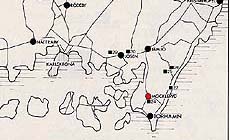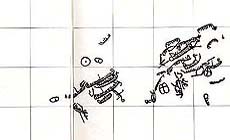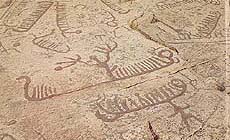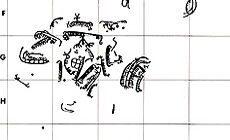|
|
 |
 |
Country: |
Sweden |
Locality: |
Möckleryd |
|
 |
Region: |
Skåne |
Area: |
Torhamn |
|
 |
 |
|
|
|
|
| |
 |
Environment & Surface |
 |
 |
 |
|
Open-air
Shelter
Cave
Portable
Megalithic
|
Geography: |
The Möckleryd locality is situated in the easternmost part of the province, on the Torhamn peninsula. 500 m from the Möckleryd schoolhouse. |
Proximity: |
Close to the Bronze Age shore line, archipelago. Close to a quarry. |
|
 |
Geology: |
Granite. |
Surface: |
Flat and smooth, with natural irregular cracks and glacial striations. Exfoliated areas occur. |
|
|
|
|
 |
 |
|
|
|
|
| |
 |
Art |
 |
 |
 |
Description: |
Engravings
Paintings
Painted engravings
High or low-relief
Sculpture
|
Figures: |
ship figures
|
|
 |
Chronology: |
Palaeolithic
Epipalaeolithic - Mesolithic
Neolithic
Copper Age
Bronze Age
Iron Age
Roman
Middle Age
Modern
Unknown
The Möckleryd carvings all belong to the Late Bronze Age, 1000-500 BC.
|
Notes: |
The ship figures bear very close resemblance to those elsewhere in Scandinavia, Scania excluded. Notable are the c. 15 ship figures with a mast placed on deck, an important document over the art of sailing in Scandinavia where no finds of ships equipped with sails have been made. Another interesting feature is a ship with a male figure in its prow, holding a snake in his hands. |
|
 |
 |
|
| |
 |
Bibliography |
 |
|
|
|
|
| |
 |
Conservation |
 |
 |
 |
Status: |
Public
Private
Park
Classified site
|
Risk: |
The major risk for carvings are chemical weathering, which makes the hard quartzite losen up and fall out, leaving white dots on the darker rock surface. Also natural weathering (mechanical weathering) during winter/spring, when water freeze in cracks and openings in the rock, creates major damage to rock faces with carvings. The biological weathering is also a danger to the rock carvings, and even to intense cleaning of the rock surface during documentation can make the rock fragile and expose the carvings to wind, water and air-born pollution. |
|
 |
Conservation: |
Good
Quite good
Mediocre
Bad
|
Intervention: |
Occasionally the rock surface are covered with earth and sand to prevent weathering. When there are animals causing damage, fences have being put up around the carved area. Signs with information have been put up for the public. |
|
 |
 |
|
|
 |
By |
 |
|
| |
| Record n. 796 / 807 |
No commercial use is allowed. Specific © is mentioned in the captions or owned by each Author or Institution |
|
| |
 |
EuroPreArt, European Prehistoric Art, is a web-based archaeological project funded by the European Union which aims to establish a lasting data-base of European prehistoric art documentation, to launch the base of an European institutional network and to contribute to the awareness of the diversity and richness of European Prehistoric Art.
It is proposed by: Instituto Politécnico de Tomar (IPT, Portugal),
CUEBC - European University Centre for Cultural Heritage (Italy - Europe),
Consejo Superior de Investigaciones Científicas (España),
Asociación Cultural Colectivo Barbaón (España),
Université de Liège (Belgique),
Gotland University College (Sverige),
University College Dublin (Eire),
Cooperativa Archeologica Le Orme dell'Uomo (Italia),
Study Centre and Museum of Prehistoric Art of
Pinerolo (Italia),
The European Centre for Prehistoric Research in the Alto Ribatejo (Portugal),
ArqueoJovem - a youth NGO (Portugal).
|
|
|
|
 |
|
 NEW: Alpine rock paintings
NEW: Alpine rock paintings



